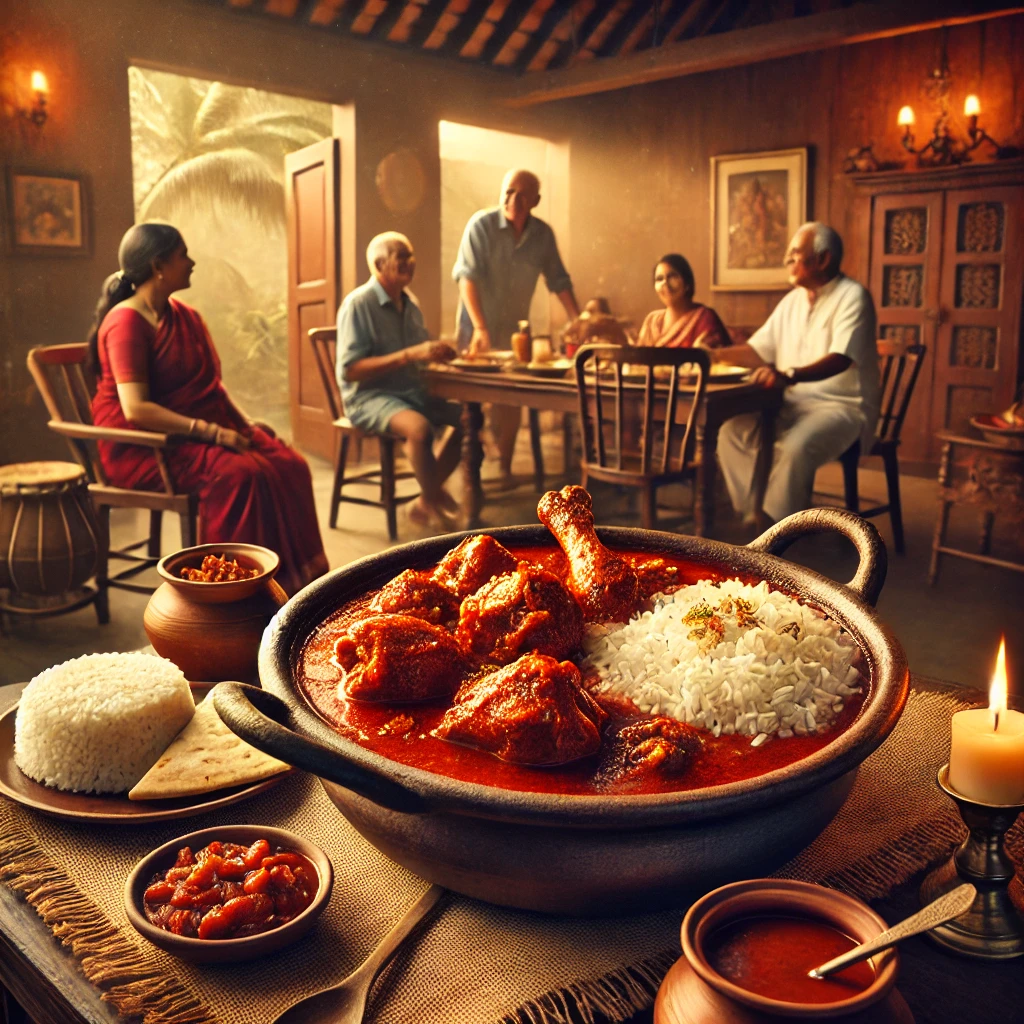Goan Vindaloo is a fiery and flavorful curry that showcases Goa’s Portuguese influence blended with Indian spices. Traditionally made with pork, but also prepared with chicken, lamb, or even seafood, Vindaloo is known for its bold, tangy, and spicy profile. The dish gets its name from the Portuguese “Carne de Vinha d’Alhos”, meaning meat marinated in vinegar and garlic. Over time, Goan spices like red chilies, turmeric, and cumin were added, giving it a distinctively rich and aromatic taste.Unlike the heavily tomato-based versions found in some restaurants, authentic Goan Vindaloo features a deep red gravy, tangy from vinegar, slightly sweet from caramelized onions, and spicy from Kashmiri chilies. It’s a dish that embodies Goa’s diverse culinary history, best enjoyed with rice or Goan pao (bread).
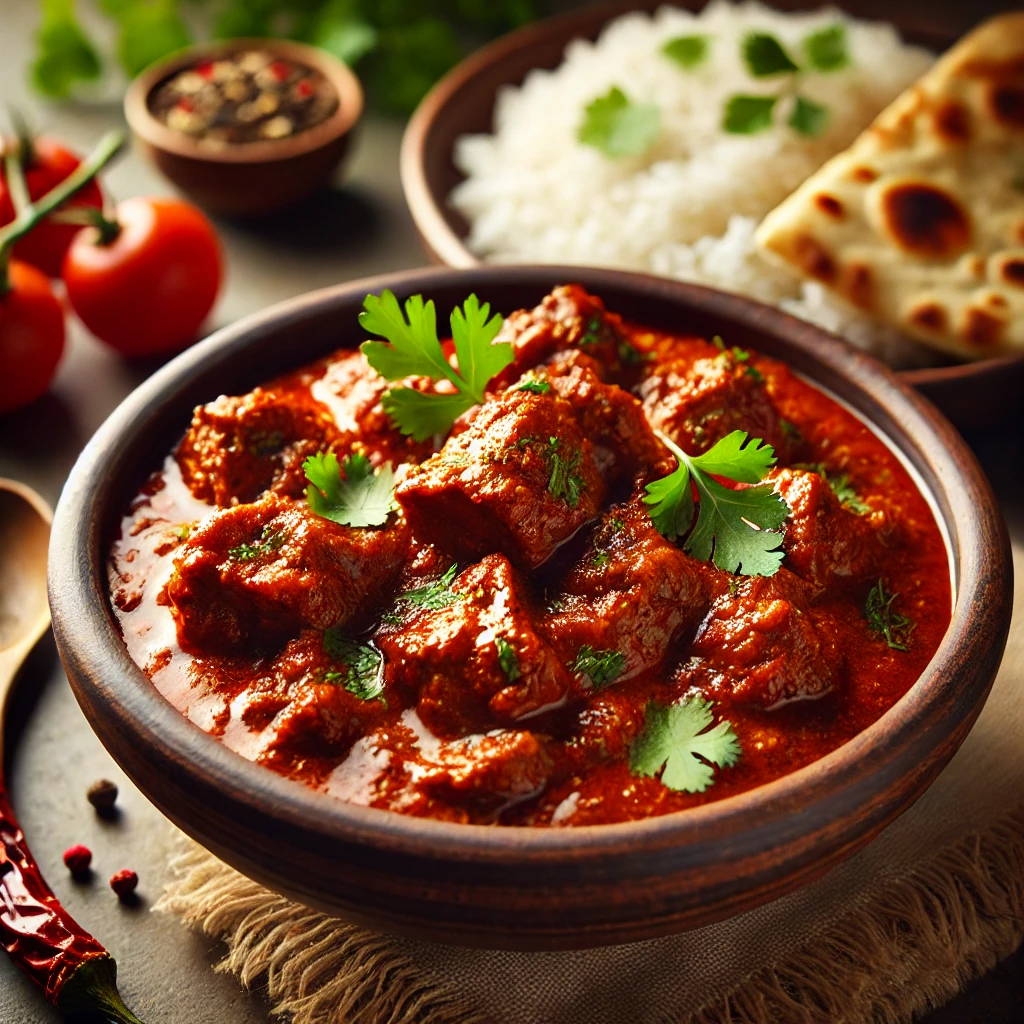
History
Goan Vindaloo has its roots in Portuguese cuisine, dating back to the 16th century when the Portuguese colonized Goa. The dish evolved from “Carne de Vinha d’Alhos”, a traditional Portuguese preparation where meat was marinated in wine vinegar and garlic to preserve it during long sea voyages. When introduced to Goa, the recipe was adapted using local ingredients like Kashmiri chilies, cumin, turmeric, and mustard seeds, replacing wine with locally available palm vinegar.Over time, the dish became an integral part of Goan Catholic cuisine, particularly made with pork, though variations with chicken, lamb, and seafood also emerged. Unlike the heavily spiced and tomato-based versions popular in British-Indian restaurants, the authentic Goan Vindaloo retains a balance of tangy, mildly sweet, and spicy flavors.Today, Vindaloo is recognized worldwide, but the true Goan version remains a unique blend of Portuguese heritage and Indian spices, making it a shining example of Goa’s rich culinary fusion.The Portuguese also introduced red chilies to India from the Americas, which became a key ingredient in Vindaloo. Goans adapted the dish by using Kashmiri chilies, which provided a deep red color and a mild heat. Over time, other Indian spices such as turmeric, cumin, coriander, and mustard seeds were added, enhancing its flavor profile.Unlike British-Indian restaurant versions that include tomatoes and excessive heat, authentic Goan Vindaloo has a delicate balance of spice, tang, and slight sweetness, often achieved with caramelized onions. Some traditional Goan households also add a hint of jaggery for a mild sweetness, making the dish even more complex in flavor.Thus, Vindaloo’s history is a story of Portuguese influence, Goan ingenuity, and global trade, blending the best of European preservation techniques with India’s rich spice heritage.
Taste Description
Goan Vindaloo has a bold and complex taste, balancing tangy, spicy, slightly sweet, and rich flavors. The first bite delivers a sharp tanginess from the vinegar, followed by a deep warmth from Kashmiri chilies, which give it a smoky yet mildly spicy kick. The garlic and ginger add an earthy depth, while caramelized onions introduce a subtle sweetness that rounds out the heat. The blend of spices like cumin, coriander, turmeric, and mustard seeds creates layers of warm, aromatic flavors, making the dish intensely flavorful but not overwhelmingly hot.The meat, often pork, chicken, or lamb, absorbs the marinade, becoming tender and juicy while soaking in the rich, slightly thick gravy. The dish has a lingering aftertaste, where the balance of vinegar, spices, and slow-cooked meat creates a satisfying umami experience. Paired with steamed rice or Goan poi (bread), Vindaloo delivers a comforting yet fiery burst of flavors, making it one of Goa’s most iconic and well-loved dishes.The dominant taste in Goan Vindaloo is a bold tanginess from vinegar, which sets it apart from other Indian curries. This is followed by a deep warmth and smokiness from Kashmiri chilies, giving it a mild yet lingering heat. The dish also carries an earthy, garlicky undertone, complemented by the rich savoriness of slow-cooked meat. A subtle sweetness from caramelized onions helps balance the sharpness of the vinegar and spices, making the overall taste tangy, mildly spicy, and slightly sweet, with a well-rounded, deeply flavorful finish.
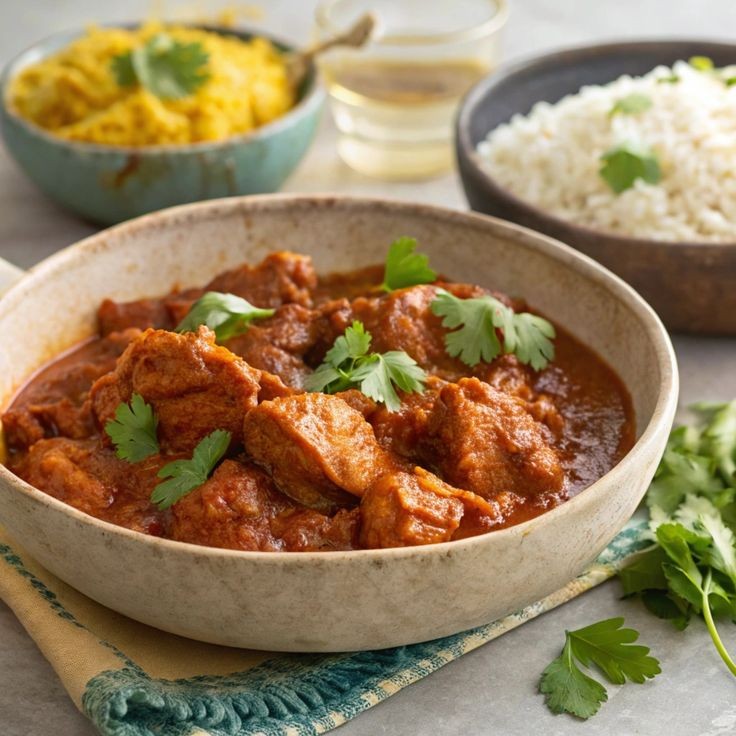
Recipe
Ingredients For the Marinade:
500g pork/chicken/lamb, cut into cubes
2 tbsp Goan palm vinegar (or white vinegar)
1 tbsp garlic paste
1 tsp ginger paste
1 tsp turmeric powder
1 tsp salt
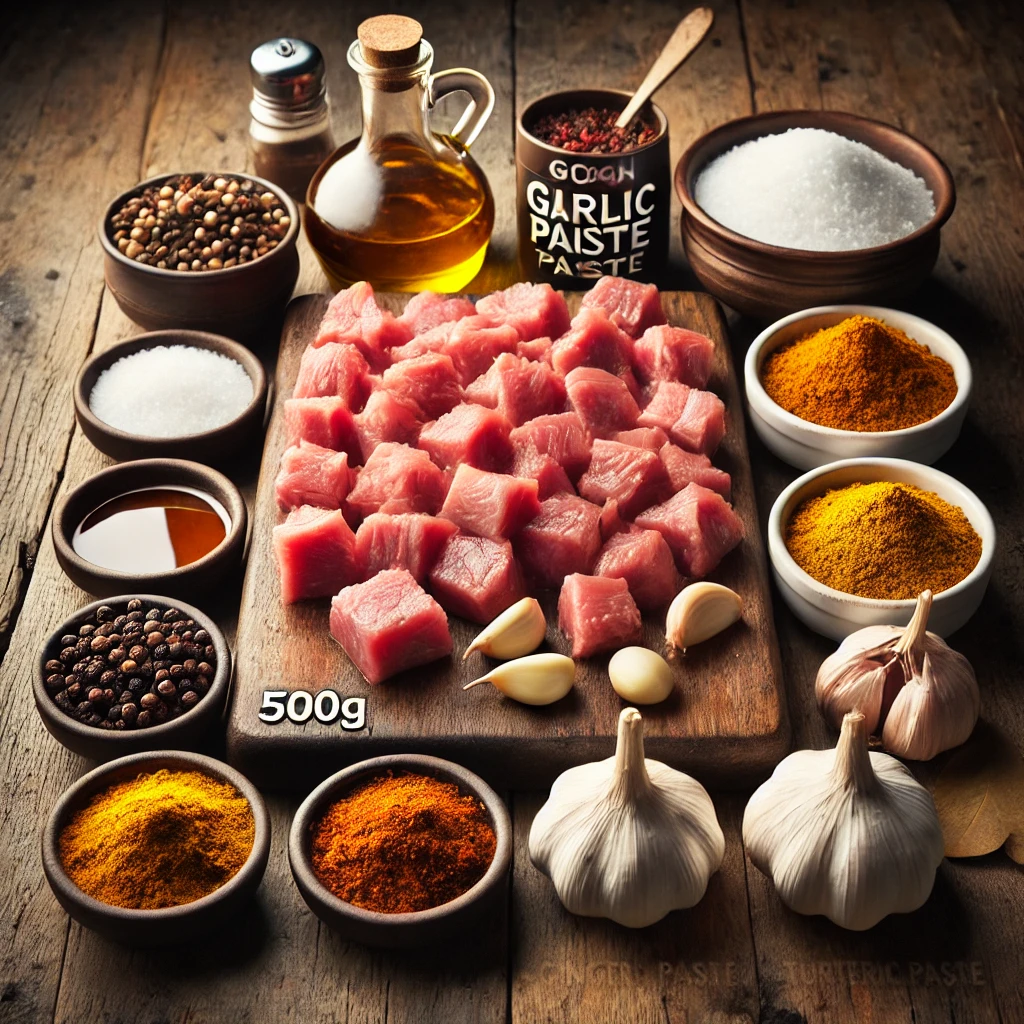
For the Spice Paste:
6-8 dried Kashmiri red chilies (soaked in warm water)
1 tbsp coriander seeds
1 tsp cumin seeds
1 tsp mustard seeds
½ tsp black peppercorns
1 tsp paprika (optional, for deeper color)
1 tsp red chili powder (adjust to taste)
1 tbsp white vinegar
1 tsp sugar or jaggery (optional, for mild sweetness)
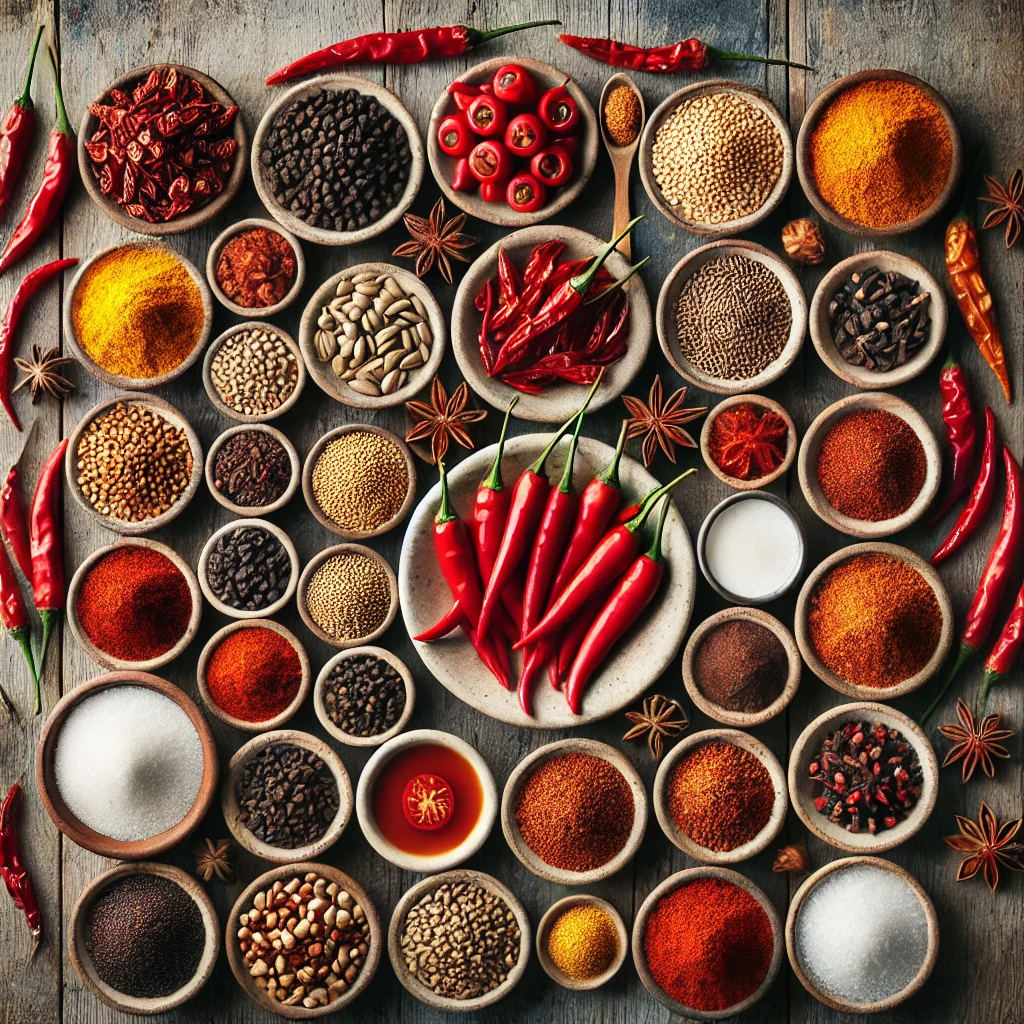
For the Curry:
2 tbsp oil (coconut or vegetable oil)
1 large onion, finely chopped
2 medium tomatoes, finely chopped (optional, not traditional but adds depth)
1 tsp garam masala
1-2 green chilies, slit (optional, for extra heat)
½ cup water (adjust as needed)
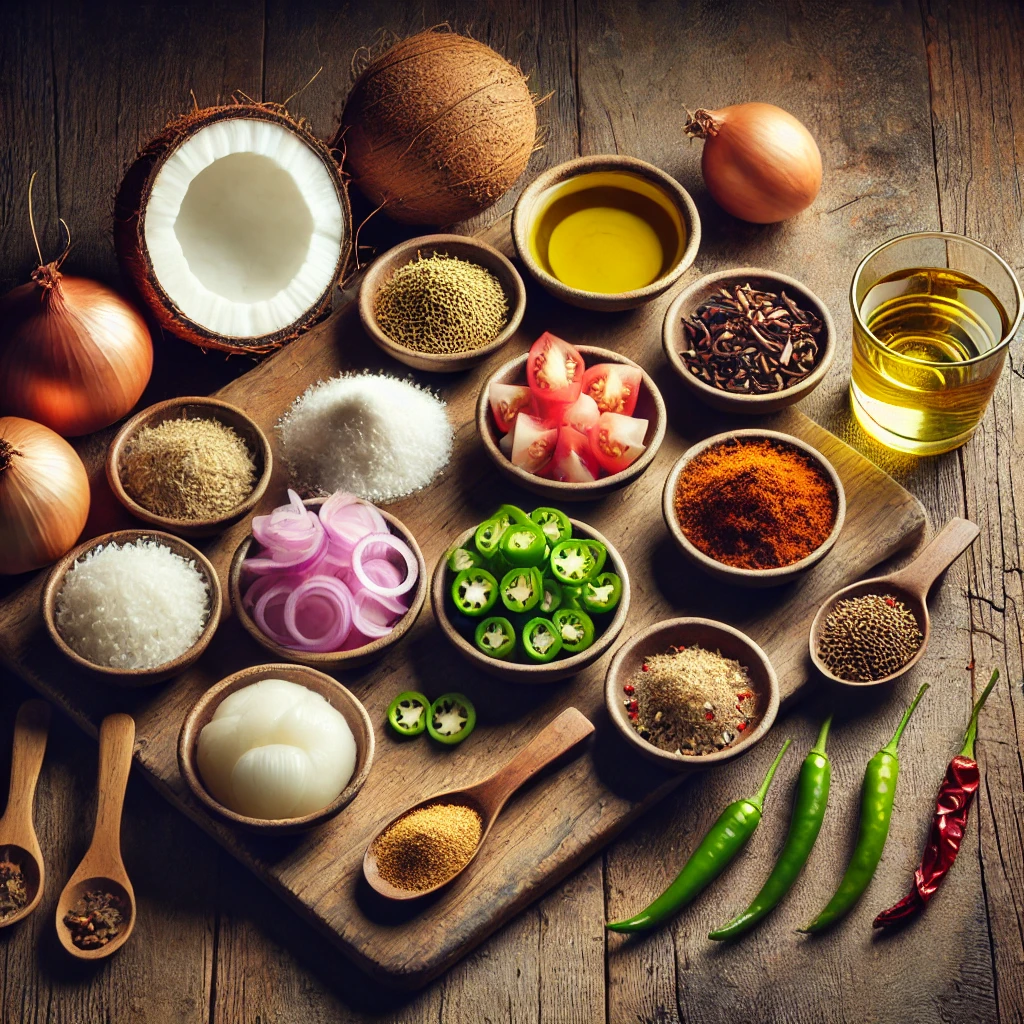
Instructions
Step 1: Marinate the Meat
1. In a bowl, mix the pork (or chicken/lamb) with vinegar, garlic paste, ginger paste, turmeric, and salt.
2. Let it marinate for at least 2 hours (overnight for best results).
Step 2: Prepare the Spice Paste
1. Dry-roast the coriander, cumin, mustard seeds, and peppercorns until aromatic.
2. Grind them into a paste along with soaked red chilies, vinegar, paprika, red chili powder, and a little water until smooth.
Step 3: Cook the Vindaloo
1. Heat oil in a pan and sauté onions until golden brown.
2. Add the prepared spice paste and fry for 2-3 minutes until fragrant.
3. Stir in the marinated meat and cook on medium heat until it browns slightly.
4. Add tomatoes (if using) and cook until they soften.
5. Pour in water, cover, and simmer for 45-50 minutes (for pork) or 20-25 minutes (for chicken). Stir occasionally.
6. Add garam masala and adjust salt, vinegar, and sugar to taste.
Step 4: Serve
Garnish with fresh coriander and serve hot with steamed rice or Goan poi (bread).
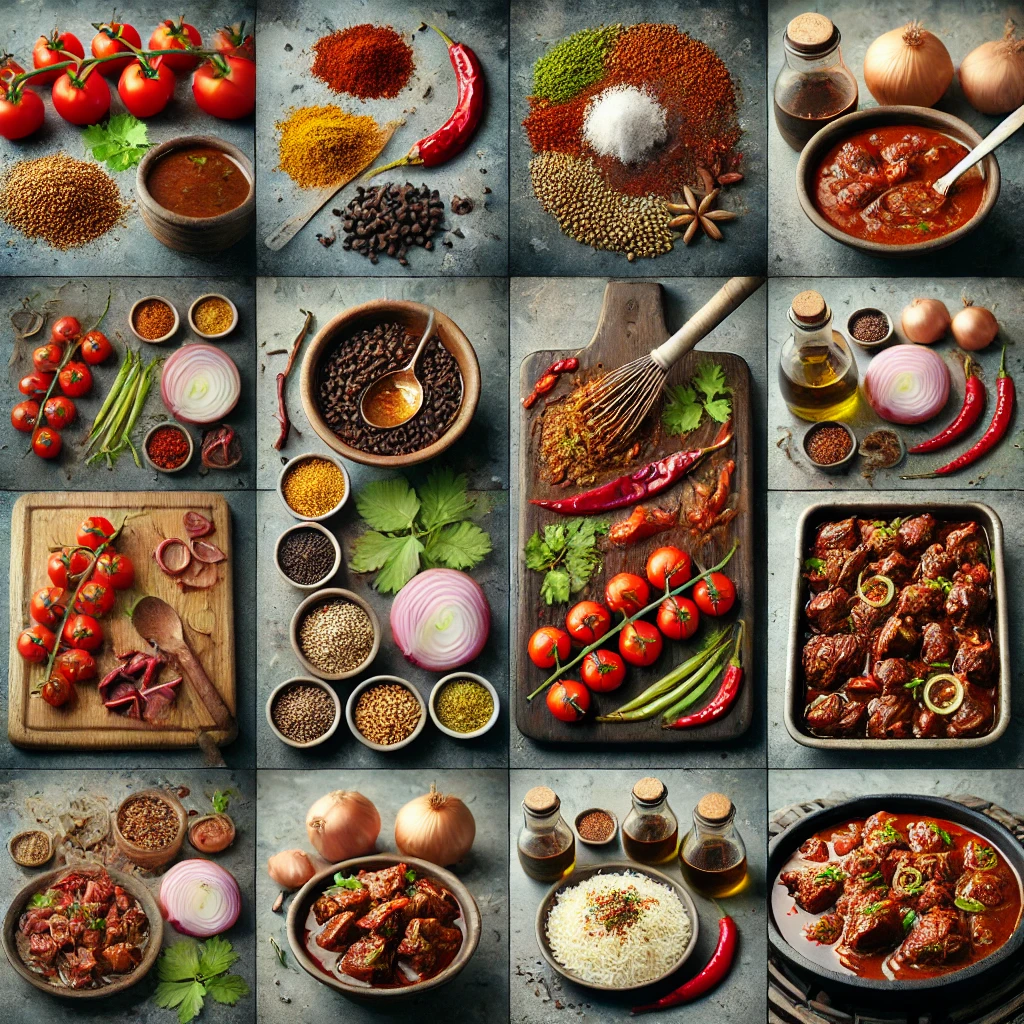
Tips
✔ Marinate overnight for deeper flavors.
✔ Adjust spice levels with more or fewer chilies.
✔ Avoid too much water—Vindaloo should be thick and rich, not watery.
Nutritional Value
Goan Vindaloo is a protein-rich dish, especially when made with pork, chicken, or lamb, which provide essential amino acids for muscle growth and repair. The use of vinegar aids digestion and helps balance blood sugar levels, while garlic and ginger contribute anti-inflammatory and immune-boosting properties. Kashmiri chilies offer antioxidants and vitamin C, promoting better immunity and skin health. The dish is also a good source of healthy fats when prepared with pork, but leaner meats like chicken make it lower in fat and calories. However, the sodium content can be high due to salt and vinegar, so moderation is key. Served with rice or bread, Vindaloo provides a balanced mix of carbohydrates, proteins, and fats, making it a flavorful yet nourishing meal.
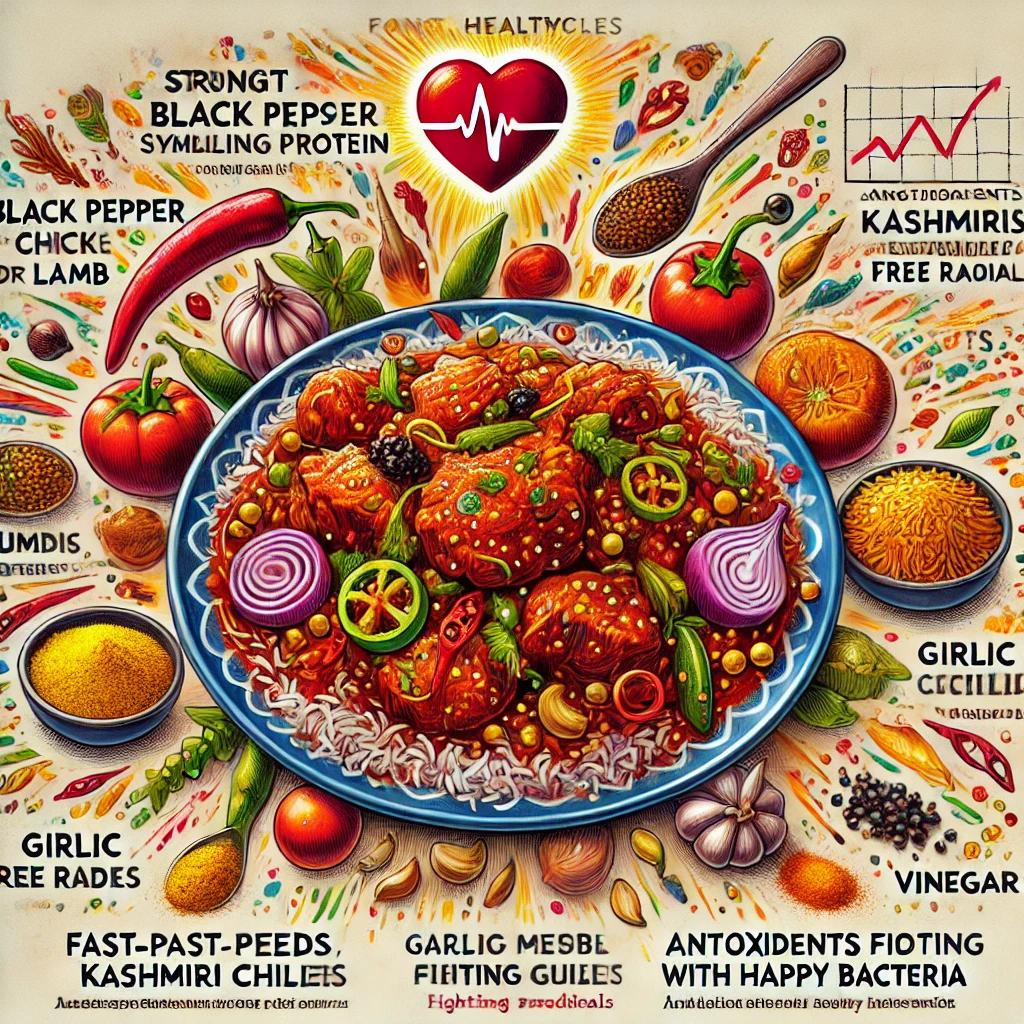
1. Rich in Protein:Pork, chicken, or lamb in Vindaloo provides high-quality protein, essential for muscle repair, immunity, and overall body function.
2. Boosts Metabolism:The spices (like cumin, black pepper, and mustard seeds) contain compounds that may enhance digestion and increase metabolism, helping with weight management.
3. Heart Health Benefits:Garlic and ginger in Vindaloo help lower cholesterol levels and support heart health by reducing inflammation and improving blood circulation.
4. Good Source of Antioxidants:Kashmiri chilies and turmeric are packed with antioxidants, which help fight free radicals and reduce oxidative stress, potentially lowering the risk of chronic diseases.
5. Supports Gut Health:The vinegar in Vindaloo promotes gut health by aiding digestion and maintaining a healthy balance of stomach acids.
6. Energy-Dense Meal:When paired with rice or Goan bread (poi), Vindaloo provides a well-balanced meal rich in carbohydrates for energy, making it a great option for active individuals.
7. Customizable for Dietary Needs:For a lower-fat version, use lean meats like chicken or tofu instead of pork.To reduce sodium intake, limit added salt and use natural flavors from spices and vinegar.
Personal Experience
Growing up in Goa, Vindaloo was always a dish that signified celebration. I still remember the first time I had authentic Chicken Vindaloo at a family gathering. The rich, tangy aroma filled the air as my grandmother carefully stirred the slow-cooked chicken in a thick, deep-red gravy. The sound of the sizzling spices and the slight vinegar tang in the air made my mouth water long before I even took a bite.When I finally tasted it, the bold flavors hit all at once—tangy, spicy, slightly sweet, and deeply rich. The chicken was incredibly tender, absorbing every bit of the masala, while the Kashmiri chilies added just the right amount of heat without overpowering the dish. The real magic happened when I paired it with steaming Goan rice and a side of poi (Goan bread)—the perfect balance of softness to soak up the gravy.To this day, every time I eat Vindaloo, it takes me right back to those family lunches—laughter, the sound of Konkani conversations, and the warmth of home-cooked food. No matter where I go, Vindaloo is a taste of Goa that always brings back memories of home.
